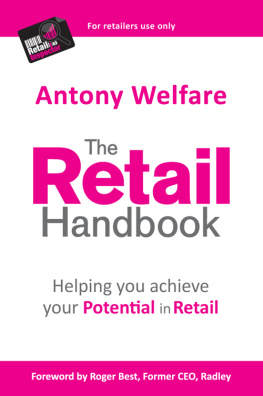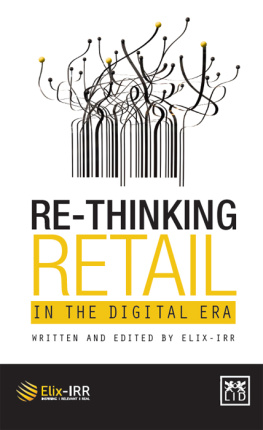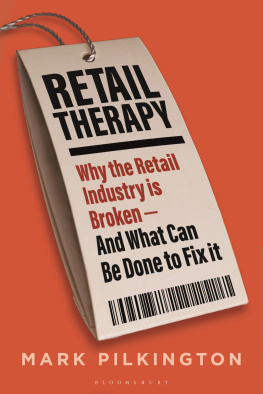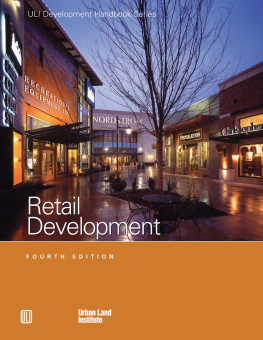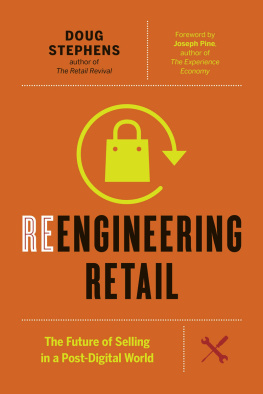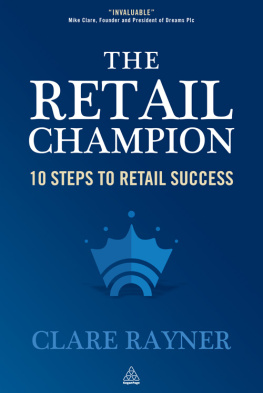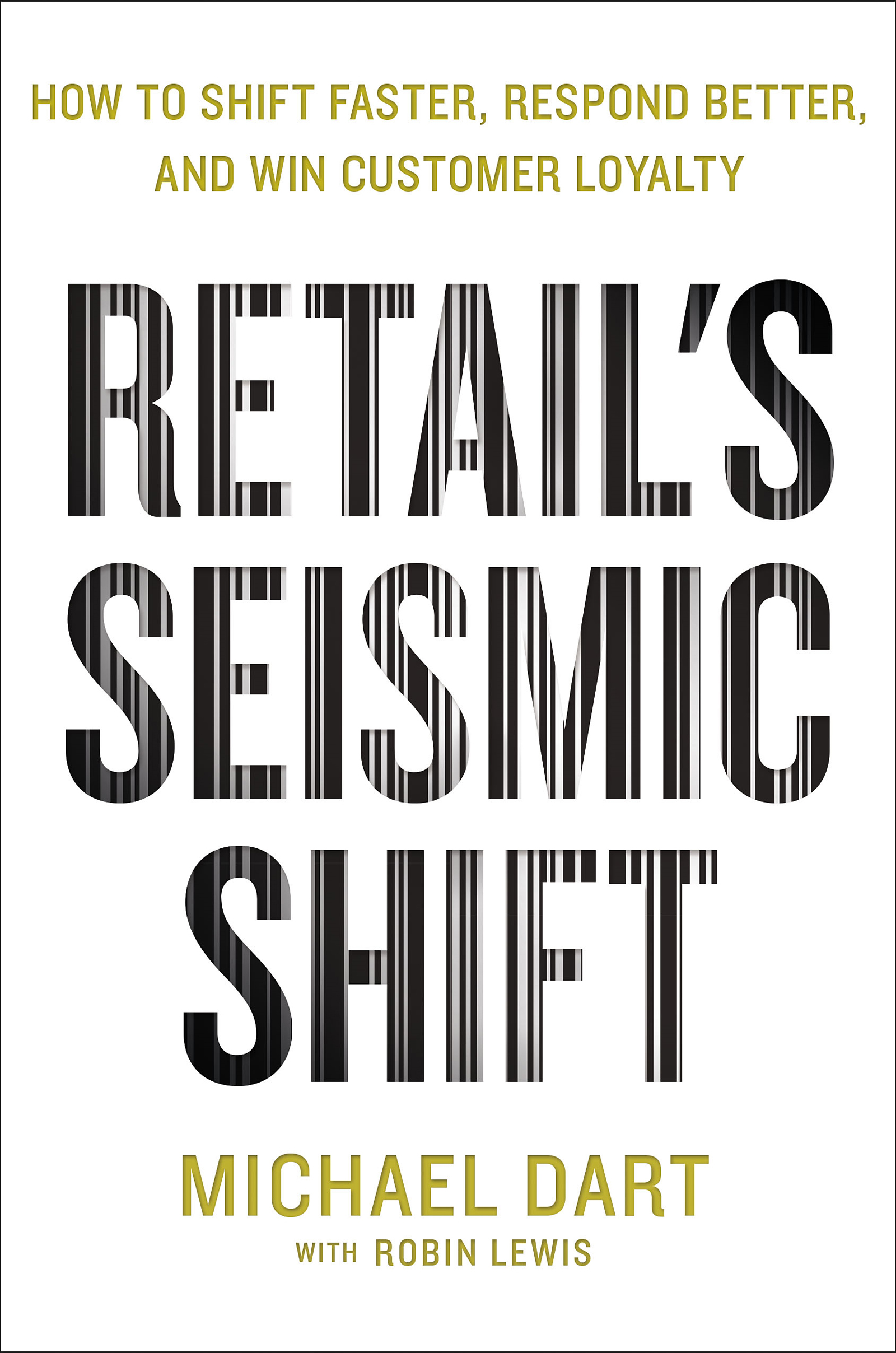Contents
Guide
Pagebreaks of the print version

The author and publisher have provided this e-book to you for your personal use only. You may not make this e-book publicly available in any way. Copyright infringement is against the law. If you believe the copy of this e-book you are reading infringes on the authors copyright, please notify the publisher at: us.macmillanusa.com/piracy.
To David, Alison, and Janine
To Martha and Cloe
For creative entrepreneurs, there has never been a better time to start a retail business. Opportunity abounds, as we shall show. For established retailers, the challenge to change has never been greater or more needed. For many, the shifts in our society we identify will prove to be too much. Extinction looms largeover stores, brands, and many consumer-facing businesseseven over the very words, language, and vocabulary of the entire retail ecosystem. The words store, retail, wholesale, even brick-and-mortar will cease to exist. They exist now only on top of fragile fault lines that are moments away from completely fracturing.
To fully understand a society, you must understand retail (commerce in its broadest sense). To understand retail (or to win in retail), you must also understand society and where it is going.
Archaeologists and historians often focus on shopping habits when seeking to describe far-away cultures or those lost in time. Exploring what, why, and how we buy offers a unique understanding of a society. From ancient Greece and Rome, where the markets became places not only of commerce but political ferment; to the Silk Road in Asia, where the spread of commerce also spread new intellectual ideas (including Buddhism from India to China); to the early markets of the Middle Ages, which revealed tight-knit localized communities, the study of retail and the consumer provides us a unique glimpse of life.
Today is no different.
Circa 2016, the earth cracked. The extreme pressure from the collision of two tectonic plates, an excess of supply and plummeting demand, triggered and accelerated what will be looked upon as the biggest and most profound economic shift in the history of the retail and consumer-facing industries. For businesses to survive the chaos and earth-shaking effects of this shift, they must fundamentally transform their business models, objectives, and strategies. Those who succeed in doing so will create a profoundly different economic and retail landscape for the twenty-first century. Those who fail to change will fall through the cracks, never to be seen again.
From a positive perspective, the shift is exciting because of the enormous opportunity to recreate the retail landscape for the better. However, it is also an enormous challenge because the changes will be hugely difficult and costly to implement. But there are no options. It is do or die.
We felt and recorded the earlier rumblings of this seismic shift in the second edition of The New Rules of Retail , published in 2014, and realized that retail would soon feel the full impact of the quake. We began to explore its genesis: the convergence of an emerging new consumer, empowered like never before on the steroids of technology and the Internet, with unlimited and instantaneous access to anything they desire.
So, when one CEO said to us, I cant believe that everything changed in August 2016, but it sure felt like it. Wow, nothing has been the same for us since then, we realized the early tremors were indeed erupting.
The general and business media were just beginning to report on some of the symptoms of the shift. The Atlantic ran a lengthy article titled The Great Retail Apocalypse of 2017. Likewise, The New York Times , The Wall Street Journal , CNBC, Bloomberg/Businessweek and various other publications all piled on the news of massive store closings, from Macys to Payless Shoes to Sports Authority to American Apparel, and dire sales and earnings reports. However, they were mostly reporting the news and facts surrounding the events. All these reports indicated that major changes to the industry were afoot, yet they failed to explain the reasons driving the change, the results, what the future looks like because of these trends, and any suggestions about what retailers could or should do about it.
This book does all that and more. We share a vision of the future and the emerging new business models that will help retailers thrive in it.
Its Not Just Technology or the Internet
Whats causing these changes?
Contrary to common belief among consultants, academicians, economists, and business executives, this seismic shift is not being driven solely by the Internet and technology. While they are powerful elements of the disruption, and will be major enablers of the changes that retailers must make, there are even larger, more dominant, forces that few have recognized. We have analyzed all of them but determined one to be the single most powerful and enduring factor driving the shift.
We believe that the disequilibrium of supply and demandnamely, an extreme and perpetually oversupplied marketplaceis the primary driver of consumer behavioral change and how technology and the Internet will be used by consumers and companies alike; this disequilibrium will essentially play the major role in how new business models must evolve.
Defying Gravity
The global supply of material possessions is growing much faster than the demand for them. This phenomenon started in Western developed nations and has slowly spread around the globe, as the sheer amount of supply continued to increase unabated. It happened quietly, unnoticed by most, and is continuing to grow. Even the most extreme anti-globalists will not be able to stop it. We will explore these global supply-and-demand dynamics in greater detail in the subsequent chapters, but let us be clear about the result: as the storehouse of virtually everything we buyfrom the shirt on your back to the phone in your pocket to the food in your fridgecontinues to grow, the prices of those items will continue to decline. Everything is headed awfully close to being free.
Basic economics tells us that the prices we pay for goods and services reflect a relative equilibrium between supply and demand. This predictable pricing is necessary to sustain healthy, growing economies. If either supply or demand overshoots the other for a prolonged period, bad things happen. Too much supply can drive deflation, and too little supply can drive inflation and economic bubbles, which will ultimately deflate. At the very least, such a huge distortion will drive equally huge strategic and structural shifts in commerce and the economy. For example, the already massive levels of discounting we see. Perhaps more important for workers and bosses alike is that, when supply exceeds demand for any extended period, companies profitability falls precipitously, forcing the demise of those with the least competitive business models.
Well go into more detail shortly, but global overcapacity has reached its tipping point, driving companies in a variety of sectors to search for new strategies and business models to regain healthy, profitable growth. Prices continue to drop yet supply only increases.
And this superabundance of material goods has also dramatically changed the way customers value things. We see among all generations the emergence of a new attitude toward material goods, marked by a greater emphasis on experiences and meaning, a massive increase in the value put on convenience, a shift away from ownership and toward collaboration (or what is being called a sharing economy), and an increasing desire to be understood as an individual. In this book we will show that these attitudinal shifts amount to the end of rampant consumerism as we know it, as consumers seek greater meaning in their lives, use their time for endeavors other than shopping, and shift away from ownership .


